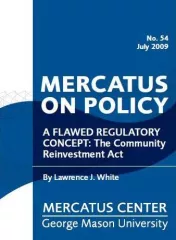- | Regulation Regulation
- | Working Papers Working Papers
- |
Beware the Rush to Presumption, Part B
Substandard Regulatory Analyses for the Affordable Care Act's Interim Final Rules
This working paper finds that the quality and use of analysis for the ACA interim final rules falls well below that of conventional notice-and-comment rulemaking by other agencies, including HHS. The poor quality of analysis in the examined ACA rules is comparable to the quality of analysis that accompanied a series of interim final homeland security regulations issued by the Bush administration following 9/11. This suggests that institutional—rather than partisan—factors explain why the quality of regulatory analysis declines when agencies implement significant presidential priorities on short deadlines.
Federal agencies issued eight major interim final regulations in 2010 to quickly implement major provisions of the Affordable Care Act (ACA). This paper employs the Mercatus Center’s Regulatory Report Card scoring system to compare the quality and use of regulatory impact analyses (RIAs) for these regulations with the quality and use of RIAs for major proposed regulations in 2008 and 2009.
The quality and use of analysis for the ACA interim final regulations falls well below the standards set by other agencies and even by the U.S. Department of Health and Human Services in conventional notice-and-comment rulemaking in previous years. The analysis in the eight ACA RIAs is comparable to the analysis that accompanied a series of interim final homeland security regulations issued by the Bush administration following 9/11. This suggests that institutional, rather than personal or partisan, factors explain why the quality of regulatory analysis declines when agencies implement significant presidential priorities on short deadlines.
To read the other papers in this study, please see: "Beware the Rush to Presumption: Regulatory Analysis and the Affordable Care Act's Interim Final Rules."


